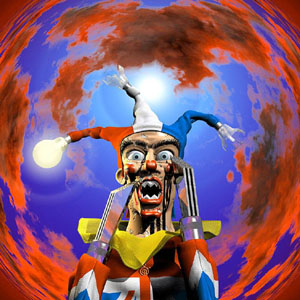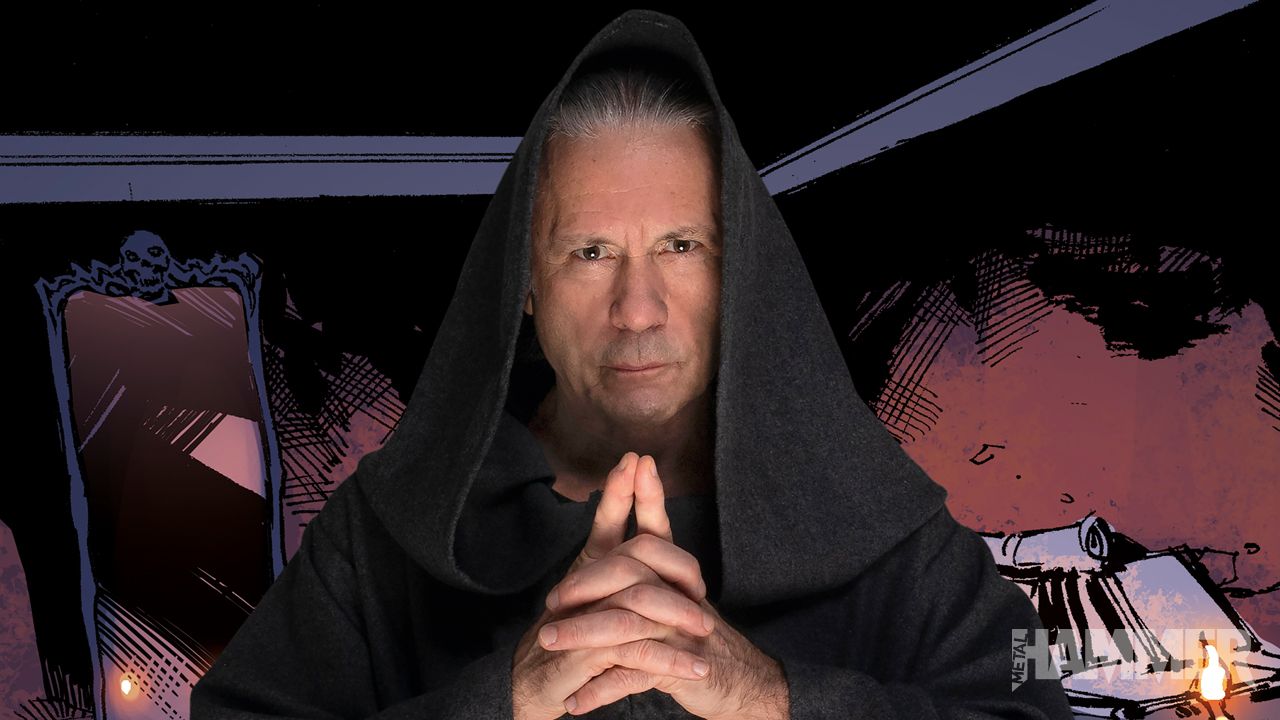Afterglow Of Ragnarok
The first chapter of our overview starts from a now well-known episode: “Afterglow Of Ragnarok” was chosen as the first single by Bruce Dickinson and, all things considered, we don't struggle to understand why.
Roy Z's main riff is powerful and modern and the vocal line of the verse becomes embedded in the listener's brain after a few listens and remains there with a certain persistence. The same can be said for the chorus, pandering and melodic at the right point, while the bridge seems a bit confusing to us, as does the slowed down section after the second chorus.
As we anticipated in the introduction, it would be impossible to choose a song that is representative of the entire album, but "Afterglow Of Ragnarok" still manages to give a nice kick-start, before the numerous surprises that await us.
Rain On The Graves
The second single presented by Dickinson is a tribute to the rock of the 70s (Deep Purple above all) and to a certain horror cinema of the same period: without Roy Z's heavy guitars, the vocal line of the verse of "Rain On The Graves" , punctuated by the beating of the bass drum, could in fact easily have been written by Ian Gillan in a song from the last ten years. Even that organ that introduces us to the chorus and the black and white film atmospheres (rightly maintained also in the video clip) immediately brought to mind Deep Purple, who in a song like "Vincent Price" had already experimented with very similar.
The continuous chanting of the song title in the chorus is excessively repetitive, but unfortunately this is a flaw that the good Dickinson seems to have carried with him for many years and which also weighs down many post-reunion Maiden songs. Apart from this aspect, overall a good song, although not among the best on the album.
-------------------------------------------------------------------------------------------------------------------------------------------------------------------
Many Doors To Hell
After such a dark start, “Many Doors To Hell” makes us understand that this will be a very different album from “Tyranny Of Souls”.
The first seconds of the song take us back in time to the days of "Tattooed Millionaire", with a more airy riff and a nice use of the Hammond organ as support.
Dickinson sings a very classic melodic line, without abstruse solutions, and when this turns into the chorus the progression immediately appears natural. The rhythm always remains square and essential, and even Roy Z never pushes too much, relying more on the melody than on the bad riffing. In the second half the song takes a break with a vaguely psychedelic parenthesis, where there is a solo by Roy Z, and then rejoins the initial structure.
Resurrection Men
We're only at the 4th song and it's already time to shuffle the cards on the table again: with "Resurrection Man" we find ourselves catapulted into a real western film: riding rhythm, acoustic guitar dictating the rhythm and, above, a line soloist by Roy Z with a Morriconian flavour.
After about a minute the acoustics step aside and the same rhythm is entrusted to the electric guitar, which is accompanied by a rather anomalous vocal line by Dickison; the chorus is very effective and this strange desert twist seems strangely intriguing to us.
We're not even halfway through the song, though, when everything changes again. In an almost unsettling way, the riding rhythm stops, the song becomes much more cadenced and Roy Z throws in a Sabbathian riff that seems to have come straight from the hand of Tony Iommi. The bass follows the cadence with viscous strokes, before ferrying us with a circular motion back into the desert dust. The song recovers the initial theme, to end again with that magnetic refrain. A decidedly unusual song and, at the same time, one of the best of the lot.
Fingers In The Wounds
Mistheria's keyboards characterize the beginning of "Fingers In The Wounds", an emphatic but never tacky accompaniment that is accompanied by an energetic yet melancholy attack from Roy Z's guitar.
When the verse begins, it switches to piano and acoustic guitar and we wonder if it's time for a ballad. In reality, this is not exactly the case: the chorus opens the gates to distortion, but the contribution of the keyboards helps to give a softer patina to the song.
About halfway through, the song takes off and runs away to the east, in a completely sudden way: the drums transform into a percussion accompaniment, the orchestrations draw Arab-like melodies and, when Roy Z joins with a beautiful solo, it seems to be halfway between “The Gates Of Babylon” by Rainbow and “Kashmir” by Led Zeppelin. The whole thing lasts just over a minute but we would have loved to hear an entire song constructed like this; instead this splendid parenthesis takes us back to the chorus and the final coda.
Eternity Has Failed
In reality “Eternity Has Failed” is exactly the same song, presented here in its original form.
We will therefore not go into a description, but rather into a comparison: the introduction in this version seemed much more effective, the sound of the keyboards less synthetic and in general the first ninety seconds have a more cinematic atmosphere, while maintaining the same the melodic and vocal line.
Having entered the heart of the song with verse and chorus, we notice a slightly slower rhythm, in which on the one hand the riding of Harris' bass is missing, which is however compensated by a more pronounced distortion of the guitars. In the verses there are cuts, with a partially reworked text, and this all in all makes this version more concise and effective, with an overall duration of about a minute and a half less (even the final monologue of Necropolis, for example, is scaled down to a single sentence).
The Maiden-esque nature of the song becomes even more evident in the instrumental section, where it is clear why Steve Harris insisted on having this song in "The Book Of Souls": here Dickinson chooses to maintain an atmosphere very similar to the original one , with Roy Z proving to be absolutely at ease even when he has to take on the role of Murray, Smith and Gers.
Mistress Of Mercy
Did you miss the sounds of “Accident Of Birth”? “Mistress Of Mercy” takes care of recovering them: both Dickinson's vocal line and Roy Z's guitar immediately take us back to the rebirth of the English singer at the end of the nineties.
A little "Road To Hell", a little "Starchildren", a spoonful of the title track, cook everything over a high flame in an alchemical alembic and at the end add a nice, very classic solo by Mr. Ramirez. Five minutes that will make the most nostalgic of those years happy, without beating around the bush.
Face In The Mirror
Before we made a mention of the theme of ballads, a territory in which Dickinson as a soloist has always stood out: “Face In The Mirror” is the first real ballad of the album, a melancholy, emotional song, with a very traditional structure and yet fully fire.
The beginning is all acoustic, with guitar, piano and an essential rhythm section to accompany Bruce's beautiful performance. Verse, chorus, verse, chorus: no flourishes, no abstruse passages, just a nice slow song done properly. Where you decide to increase the intensity, you rely more on piano and hammond, with an atmosphere close to that of "Navigate The Seas Of The Sun" which won us over at the time of "Tyranny Of Souls".
Shadow Of The Gods
In our track-by-tracks we always try not to go too far in our judgments, limiting ourselves more to the descriptive part and postponing any judgment during the review, giving the album the right amount of time to be understood and assimilated.
However, if today we had to choose the song that convinced us most of all, the choice would probably fall on "Shadow Of The Gods". This song also begins as if it were a ballad: it starts with the piano and Dickinson's voice becomes particularly dramatic here. If the melancholy of “Face In The Mirror” was more intimate and confidential, that of the first part of “Shadow Of The Gods” is solemn and majestic, thanks to an excellent use of orchestrations.
After just over a minute, bass and drums enter and from the back comes an orchestral accompaniment with brass instruments to give a cinematic feel, almost like a James Bond soundtrack. We were not able to see the exact credits of each song, so we assume it is the work of Mistheria - former Dickinson keyboard player at the time of "Tyranny Of Souls" - and it makes us particularly proud to find such a precious contribution from an Italian artist on this album.
The music grows in intensity and Bruce in turn follows its progress by raising the tone, but without exaggerating or 'choking up', as sometimes happens to him. At the stroke of the fourth minute, this symphonic wave dies down and the dust is set on fire. Roy Z plays everything on an essential riff of pure classic metal, which seems to come from the pen of Adrian Smith and thus guides us towards the finale. A comparison that could be useful for this song is "Omega", from "Accident Of Birth", with the same structure, first enveloping and then incendiary, with the addition of this beautiful orchestral evening dress.
Sonata (Immortal Beloved)
We were very curious to listen to the final song of "The Mandrake Project", partly because of the title, which is so evocative, and partly also because of the long duration. We weren't ready, however, to find ourselves faced with a non-song. “Sonata”, in fact, completely eschews the typical structure we are used to, instead transforming itself into a sort of dream journey, in which the narration takes precedence over the arrangements.
In the first part of the song, Roy Z's guitar and a carpet of keyboards accompany Bruce's voice with an arpeggio, with the rhythm marked by a minimal rhythm track. Having reached what we could define as a sort of chorus (in which Bruce obsessively repeats the line "Save me now"), the guitar accompaniment becomes more robust, but everything always remains very dilated, diluted and, we are very sorry to say , even a little boring. We are more or less five minutes in and up to this point what we have listened to still has its own defined form, perhaps not exciting, but still defined.
From here, however, the structure of the song becomes even more frayed and dreamlike: basically the arrangement continues to provide a musical base that alternates more dreamy moments with more electric and robust ones, but Bruce's singing loses any form of formal coherence: it's as if he was simply improvising sung parts on a text, a sort of work in progress that hasn't yet been given a finished form, in which the singer simply seems to follow the inspiration of the moment to find it.
Roy Z's final solo is intense, of course, but this very long coda is something that even today, after numerous listens, we have not been able to understand. On the other hand, perhaps it is precisely this elusive nature that is the essence of "The Mandrake Project".


) and the French gastronomy, but I’d rather have baked beans than snails!

 The worst is that french people also eat other disgusting things like brains (they are real zombies some time to time), balls and guts...
The worst is that french people also eat other disgusting things like brains (they are real zombies some time to time), balls and guts... 




www.loudersound.com


 metalitalia.com
metalitalia.com

metalitalia.com

